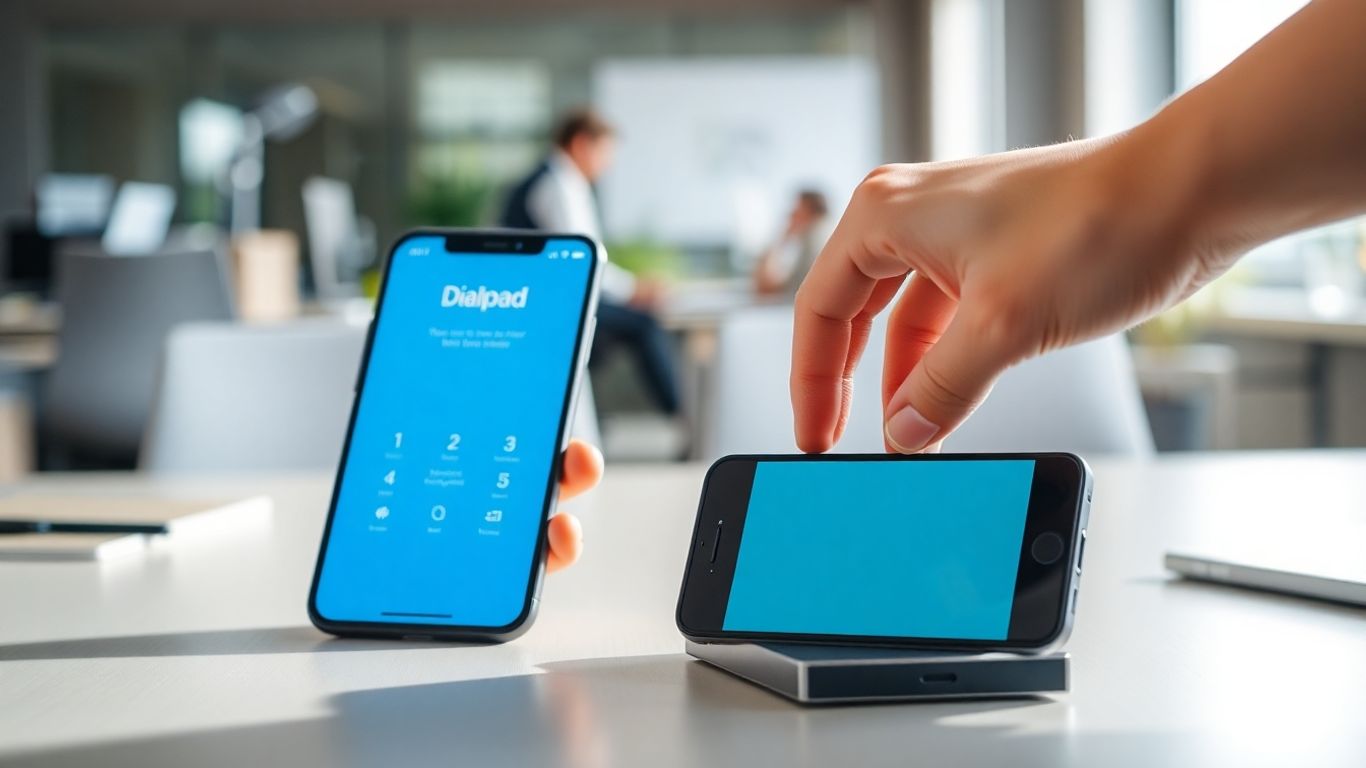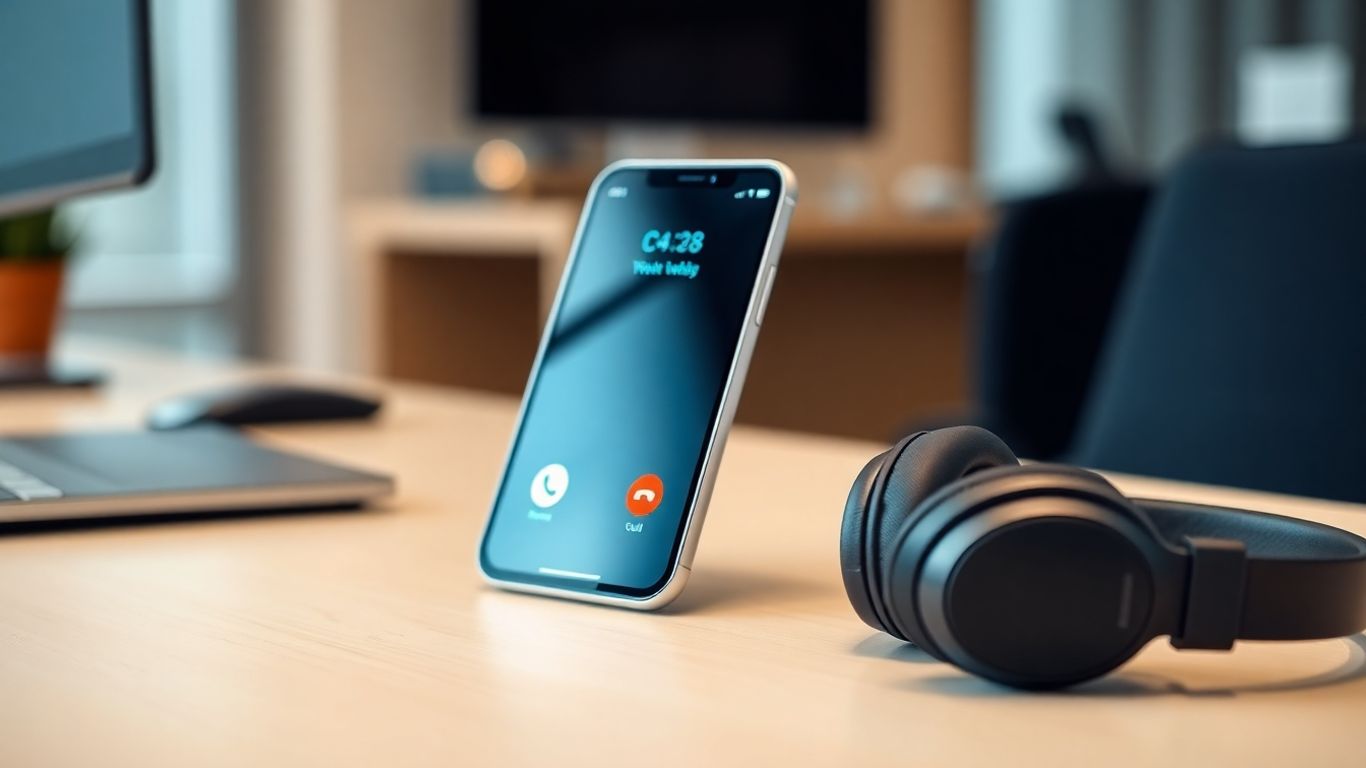Finding the right phone system for your business can feel like a puzzle, especially when you're trying to keep costs down. An auto attendant phone system can really help manage calls, making sure customers get to the right place without you needing a full-time receptionist. We're looking at some of the best free auto attendant phone system options out there for 2025, so you can make a smart choice without breaking the bank. Let's see what's available.
So, let's talk about My AI Front Desk. This isn't your grandma's answering machine, that's for sure. It's basically an AI-powered receptionist that can handle a surprising amount of your business's phone interactions, 24/7. Think of it as hiring a super-efficient employee who never sleeps, never takes a break, and can talk to thousands of people at once.
What can it actually do? Well, it's designed to answer company-specific questions, schedule appointments, and generally chat with customers over the phone or even via text. It's built to sound like a human, which is pretty wild when you think about it. The setup is supposed to be quick, like, under five minutes, which is a nice change of pace from some tech setups. You just give it information about your business, and it's ready to go.
Here's a quick rundown of what makes it stand out:
The biggest selling point here seems to be the sheer speed and responsiveness. We're talking response times measured in milliseconds. This means conversations feel natural, not like you're waiting for a robot to process your request. It's designed to eliminate that frustrating lag you sometimes get with automated systems, making the customer experience much smoother.
They also offer different plans, including enterprise solutions for larger call centers and even white-label options if you want to rebrand it for your own clients. Plus, there's a free 7-day trial, so you can test the waters before committing. It's definitely an interesting option if you're looking to automate your front desk operations without losing that personal touch, or at least, a very convincing imitation of it.
3CX is a pretty solid option if you're looking for a phone system that can handle your auto attendant needs. It's not just a simple auto attendant; it's a full-blown IP PBX software that you can install either on your own servers or in the cloud. This gives you a lot of flexibility, which is always a good thing for businesses.
What really makes 3CX stand out is its ability to integrate with other tools you probably already use, like CRM systems. Imagine a call coming in, and your auto attendant not only directs the caller but also pulls up their customer record in Salesforce or HubSpot. That's the kind of efficiency we're talking about.
Here are some of the things you can expect:
Setting up 3CX can feel a bit more hands-on than some cloud-only solutions, especially if you opt for the on-premises deployment. You'll need to manage the server and software updates yourself, or work with a partner who can handle that for you. But for businesses that want more control over their infrastructure or have specific integration needs, this is a big plus.
It's a system that can grow with you, from a small startup to a larger enterprise, and it's definitely worth considering if you want a powerful and customizable auto attendant feature as part of a broader communication platform.

Dialpad is a pretty solid option if you're looking for a unified communications platform that really leans into AI and analytics. It bundles together voice, SMS, team chat, and video meetings, which is handy. What I found particularly cool is that they offer business numbers from over 70 countries, not just the US, which is a nice touch if you're doing international business.
Their desktop app has a clean interface, and honestly, it's one of the easier ones to get around. A big plus is that even their lower-tier plans include real-time analytics and live call transcription. Most companies save that stuff for the premium packages, but Dialpad makes it accessible. You can build out your auto-attendant call flows using a drag-and-drop builder, which makes setting up different branches for announcements or directing calls pretty straightforward. Plus, the AI transcription works on your IVR interactions too, so you can see what customers are saying even before they reach a person.
Here's a quick look at some of the features:
The pricing starts around $27 per user per month, which is a bit higher than some others, but you're getting a lot of AI-powered features baked in. If you're trying to get insights into agent performance or customer behavior, the analytics alone might make it worth the cost. Just be aware that the monthly SMS limits can be a bit restrictive, and if you need CRM integrations like Salesforce or HubSpot, you'll have to step up to their Pro plan.
Dialpad also offers a 14-day free trial, so you can always test it out before committing. It's a good way to see if their AI features and user interface fit your team's workflow. For businesses that want to really understand their call data and automate more of their communication, Dialpad is definitely worth a look. You can check out their full review for more details on how it stacks up.
RingCentral is a pretty solid option if you're looking for a phone system that does more than just handle calls. It's got this auto-attendant feature that's quite capable, letting you set up multi-level IVR menus. You can build out pretty complex call routing systems using their drag-and-drop tool, which is nice because it means you can really tailor how calls get directed to different people or departments. Plus, they include toll-free numbers and a bunch of minutes with every plan, which is a good perk for encouraging customers to call in, especially if they're international.
What's interesting is that RingCentral also bundles in team chat and video conferencing. So, if your team needs more than just a phone system, this could be a good all-in-one solution. Setting up the auto attendant itself was pretty easy when I looked into it; the app felt intuitive enough. They also boast a huge number of integrations with other business tools, which is always a plus for keeping everything connected.
Here's a quick look at some of their features:
While RingCentral offers a lot, it's worth noting that it can be a bit pricier than some other options out there. The monthly SMS limits are also pretty restrictive, which might be a problem if your business relies heavily on text communication. But if you're looking for a robust system with strong auto-attendant capabilities and integrated collaboration tools, it's definitely worth considering. You can check out their pricing details to see if it fits your budget.

Zoom Phone is a pretty solid option if you're looking for a phone system that plays nice with other tools you might already be using, especially if your team is already on Zoom for meetings. It's known for being quite budget-friendly, which is always a plus for businesses trying to keep costs down. You get unlimited domestic calling in the US and Canada for a pretty low monthly fee per user, which is hard to beat.
One of the cool things is how it integrates with Zoom Meetings. You can start a whiteboard session or share notes from a chat and then easily jump into a video call to continue the conversation. It makes switching between different communication methods feel pretty smooth.
Here's a quick look at what you get:
While it's generally easy to use, especially if you're familiar with Zoom's other products, it's worth noting that some advanced analytics aren't included in the basic package and might require an add-on. Also, everyone gets the same set of features, so there isn't a lot of flexibility to pick and choose specific feature tiers. But for many businesses, the all-in-one approach and the low starting price of $15 per user per month make it a really attractive choice. It's a good way to get a lot of functionality without breaking the bank, especially if you're already invested in the Zoom ecosystem. You can even add Zoom Meetings for just a few extra bucks a month per user, which is a nice bonus. If you're looking for a cost-effective way to handle your business calls and team chat, Zoom Phone is definitely worth a look. You can find more details about their plans on Zoom's website.
Zoom Phone offers a straightforward setup for auto-attendants, even without a drag-and-drop builder. The interface is designed to be user-friendly, allowing you to manage calls, chats, and voicemails from a single, clean desktop application. This unified approach helps reduce the feeling of jumping between different software windows.
They also offer hardware rental options, which can help lower the initial cost of setting up your phone system. It's a good way to get the equipment you need without a large upfront investment.
Nextiva is a pretty solid option if you're looking for a phone system that bundles a lot of different communication tools together. It's not just about calls; they throw in things like team chat, SMS, and even live chat, which is kind of neat. They also have this feature where you can manage social media messages and reviews right from their app. So, if your team is small and can handle a few different communication channels, Nextiva could be a good fit.
When it comes to the auto-attendant part, Nextiva has you covered. Their higher-tier plans, like the Power Suite, offer more advanced stuff like skills-based routing. This means when someone calls, the system can actually look at your CRM and try to send the caller to the person best suited to help them. That's pretty smart.
Here's a quick look at their plans:
They also offer a 7-day free trial, which is always a good way to kick the tires.
One thing to keep in mind is that Nextiva doesn't have a ton of integrations compared to some others out there – we're talking about 19, which is way less than some competitors who offer hundreds. Also, when we tested their mobile app, some notifications, especially for voicemails, seemed a bit slow to arrive. It's not a dealbreaker, but it's something to be aware of.
While Nextiva's lower plans have basic auto-attendant features, the higher-end plans really shine with more complex routing options. This can make a big difference for businesses that get a lot of calls and need to direct them efficiently without a human operator having to do all the sorting.
They do offer some free phones for new customers, but they have to be Nextiva-branded ones. So, if you're buying a bunch of lines, that could be a nice perk.
Talkdesk really stands out because it's not just a phone system; it's a full-blown contact center. This means you can handle customer interactions not only through voice calls but also via SMS, social media, live chat, and email. It's a lot, but they've managed to make it work.
The real magic is in their drag-and-drop builder, which lets you set up auto attendants and even live chatbots without needing to be a tech wizard. You can design pretty complex call routing systems with features like ring groups and call queues. It's designed to automate a lot of tasks, not just the phone calls.
Here's a quick look at what it offers:
While Talkdesk offers a ton of features and advanced tools, it does come with a higher price tag. It's a fantastic option if you're looking to provide a complete, multichannel customer service experience. However, if you only need a basic auto attendant for your phone system, it might be more than you need.
Key Features at a Glance:

Aircall is a pretty slick option if you're looking for a cloud phone system that really focuses on making your customer service and sales teams work better together. It's got this auto attendant feature that's not just basic; it lets you build out pretty complex call flows. You can connect different queues, set up language options, and use text-to-voice menus to guide callers. It feels professional, and the interface is clean, which is nice because sometimes these systems can get a bit overwhelming.
What really stands out with Aircall is how it handles call routing. It can route calls based on things like an agent's specific skills or the language they speak. Plus, it has some neat supervisor tools, like AI-powered insights into calls and the ability to monitor calls with whisper and barge-in features. This is usually something you see in more expensive, dedicated call center software.
However, Aircall isn't the cheapest out there. You need at least three licenses to even sign up, and some of the really advanced features are locked behind their higher-tier plans. It's definitely an investment, but if you need that advanced call handling for customer support or sales, it might be worth the extra cost.
Here's a quick look at some of its specs:
Aircall's drag-and-drop call flow designer is a big plus, making it easier to visualize and set up how calls are handled. It also offers queue callbacks, which is a lifesaver for callers who don't want to wait on hold – they can hang up and get a call back when it's their turn.

When you're looking at phone systems, 8x8 is definitely one to consider, especially if your business does a lot of international calling. What really sets them apart is their huge unlimited calling area. We're talking 14 countries, including places like the UK, India, and Australia. Most other services limit that to just the US and Canada, so if you're frequently on calls with clients or partners overseas, this could be a big money-saver.
They've got the standard auto-attendant features you'd expect, like call queues and IVR menus, and they even have a drag-and-drop tool to build out your call flows. It's pretty colorful, though I found it a little more complicated to get the hang of compared to some others. The interface overall is functional but not exactly flashy. It gets the job done, but it's not the prettiest thing you'll ever see.
Here's a quick look at some of their specs:
While 8x8 offers a solid set of features for managing calls and internal communication, its real strength lies in its global reach. If international calls are a significant part of your business, the value proposition here is pretty strong. For businesses that stick mostly to domestic calls, there might be more budget-friendly options available that do just as well.
They also have a separate app called 8x8 Frontdesk, which is designed specifically for receptionists. It makes handling a lot of calls easier with quick access to contacts and call controls. On their higher-tier plans, you can even get call monitoring tools, which is handy for supervisors wanting to keep an eye on things. And if you do a lot of video meetings, their platform supports up to 500 participants, which is pretty impressive.
Intermedia Unite is a business phone system that offers a range of communication tools, including voice, SMS, team chat, and video meetings. It's designed to bring different communication methods together in one place.
When it comes to auto attendants, Intermedia Unite provides features that help direct calls efficiently. You can set up automated greetings and menus so callers can reach the right person or department without needing a live operator for every call. This can save time and make things smoother for your customers.
Here are some of the ways Intermedia Unite handles call routing:
The platform aims to simplify how businesses manage their communications. It also offers integrations with other business tools, which can be helpful for keeping your workflows connected.
Intermedia Unite's pricing starts around $27.99 per user per month. This includes access to voice, SMS, team chat, and video conferencing features. They also highlight unlimited calling to over 33 countries, which is a nice perk if your business has international clients or partners.
Our AI receptionist is always ready to help, day or night. It can answer calls, help customers find what they need, and even set up appointments. Think of it as your super-helpful assistant that never sleeps! Want to see how it works for your business? Visit our website to learn more and get started.
So, there you have it. Finding the right free auto attendant system for your business in 2025 doesn't have to be a headache. We've looked at a bunch of options, and honestly, there's something out there for pretty much everyone, whether you're a tiny startup or a growing company. These systems can really help make your phone calls smoother and make your business look more professional, all without costing you an arm and a leg. Take your time, check out a few, and see which one fits your needs best. It's a smart move that can save you time and maybe even bring in more customers. Good luck!
Think of an auto attendant as a virtual receptionist for your business. When someone calls, it answers automatically and then gives options, like 'Press 1 for sales, press 2 for support.' This helps direct callers to the right place without needing a person to answer every single call.
It can save money by reducing the need for a full-time receptionist to answer and route calls. Plus, it helps make sure customers get to the right department faster, which can lead to quicker sales and better service, ultimately bringing in more money.
Absolutely! Many auto attendant systems can be set up to provide different greetings and options for after-hours calls. They can take messages, direct calls to voicemail, or even let callers know when you'll be back open.
Most modern systems are designed to be user-friendly. Setting them up usually involves simple steps like recording greetings and deciding on the menu options. Many can be up and running in just a few minutes.
An auto attendant is like a basic menu system ('Press 1 for X'). An IVR (Interactive Voice Response) system is more advanced. It can understand spoken words or gather more information, like asking for an account number to check an order status.
Yes, definitely! You can record your own greetings and prompts to match your company's tone and style. This makes the system sound professional and personal, rather than robotic.
Many of the best systems offer integrations. This means they can connect with your customer relationship management (CRM) software or other tools, making it easier to manage customer information and streamline tasks.
While many advanced systems have costs, some providers offer basic auto attendant features as part of their free or very low-cost plans, especially for small businesses. It's worth checking out options like My AI Front Desk, which often have free trials or starter plans.
Start your free trial for My AI Front Desk today, it takes minutes to setup!








